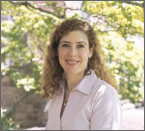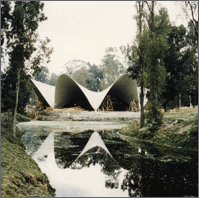Félix Candela: Strength and Elegance in Structural Engineering
 SEMM SEMINAR
SEMM SEMINAR
This seminar is sponsored by the Pacific Earthquake Engineering Research Center
Maria E. Moreyra Garlock
Department of Civil and Environmental Engineering
Princeton University
Monday, October 4, 2010
12:00-1:00 pm in 502 Davis Hall
 Abstract: Félix Candela is one of the greatest structural
engineers of the twentieth century. Born in Spain, he was
exiled to Mexico in 1939, where he created all of his ma-
jor thin shell concrete constructions. Candela’s work de-
monstrates three ideas that are essential to the education
of structural engineers and to anyone with an apprecia-
tion for the built environment: first, the true ethos of engi-
neering, namely, to conserve natural resources by mini-
mizing materials; second, the ethic of engineering, to re-
duce cost by intimately connecting design to construction;
and third, the aesthetic of engineering, to create beautiful
forms. All of these concepts are realized in the thinness
of Candela’s concrete shells, with their grace and refine-
ment of form, and their endurance. The presentation ex-
amines these three ideas, and it presents a detailed ex-
amination of Candela’s greatest works through a structural engineering lens.
Abstract: Félix Candela is one of the greatest structural
engineers of the twentieth century. Born in Spain, he was
exiled to Mexico in 1939, where he created all of his ma-
jor thin shell concrete constructions. Candela’s work de-
monstrates three ideas that are essential to the education
of structural engineers and to anyone with an apprecia-
tion for the built environment: first, the true ethos of engi-
neering, namely, to conserve natural resources by mini-
mizing materials; second, the ethic of engineering, to re-
duce cost by intimately connecting design to construction;
and third, the aesthetic of engineering, to create beautiful
forms. All of these concepts are realized in the thinness
of Candela’s concrete shells, with their grace and refine-
ment of form, and their endurance. The presentation ex-
amines these three ideas, and it presents a detailed ex-
amination of Candela’s greatest works through a structural engineering lens.
Speaker: Dr. Garlock received her BS degree from Lehigh University and a MS degree in Civil Engineering from Cornell University. Upon completion of her MS degree, she worked for Leslie E. Robertson Associates in New York as a structural engineer, where she had the opportunity to design many interesting buildings including some skyscrapers. Four years later, Dr. Garlock returned to Lehigh, this time in pursuit of her Ph.D. degree, which she received in 2003. Dr. Garlock is currently an Assistant Professor in the Depart- ment of Civil and Environmental Engineering of Princeton University. She teaches several courses related to structural engineering and does research related to improved design for the response of structures to large earthquakes and large fires. In addition, she studies the best examples of structural designs of the present and past (i.e. “structural art”) and uses this to inspire her research and teaching.
Please consult the seminar web page for future updates: http://www.ce.berkeley.edu
posted Octoboer 5, 2010

